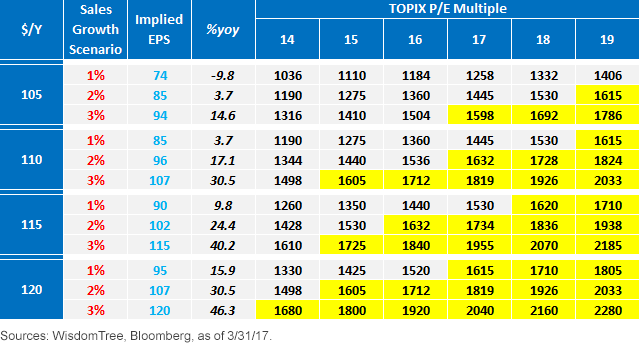Japan Outlook Past Golden Week–Show Me The Money
We maintain our view that Japanese risk assets—equities and real estate—are on track for a multiyear structural bull market. 2017 is poised to bring a positive reversal of earnings momentum, with a pickup in top-line sales growth and a weaker currency capable of delivering 25% to 30% earnings growth (after last calendar year’s drop of around 8%).1 Given the relatively attractive valuation backdrop—TOPIX is trading at a modest discount to its 10-year averages on both trailing and forward price-to-earnings (P/E) multiples—the rising visibility of earnings is likely to be the principal driver of Japan’s market performance. In contrast, policy action and initiatives are expected to be relatively less important market drivers for Japan, with the Bank of Japan (BOJ) expected to stay put and maintain its zero-rate 10-year bond yield target for the foreseeable future.
Focus on Corporate Results
Now that the U.S.-Japanese bilateral economic, trade and investment dialogue is off to a good start—last week’s first round of meetings went well and constructive engagement has been agreed upon—the next key to propelling Japanese markets out of the disappointing downward adjustment is poised to be the upcoming corporate results season. As that overlaps with the annual “Golden Week” holidays, Japan’s performance is expected to rise in coming weeks, in our view.
Specifically, we expect a steady stream of upward revisions as companies report their full fiscal year earnings end-April/early May. This is because baselines are still very conservative, with companies and analysts still “budgeting” for an average ¥/$ exchange rate of around 105 and top-line sales growth of just below 2%. Note that for every 10 yen of yen depreciation, listed companies receive a windfall profits boost of around 8%. Given that the actual realized exchange rate in the January–March quarter was around ¥113, that would suggest a rise in profits of around 15%, rather than the 8% anticipated by the corporate consensus.2
Of course, forward guidance is going to be key. Here, we anticipate another year of conservative benchmarking with companies likely to budget for around ¥108–110/$ and sales growth of around 2%. Our models suggest this implies potential earnings growth of around 17.1% for the new fiscal year (starts April 1, 2017, and runs through March 31, 2018). However, if top-line sales growth—which is basically global economic growth—rises by 3%, profits should rise by 30.5%, even if the currency averages the same ¥110/$. Given the recent acceleration in global growth and inflation momentum, Japanese corporate earnings momentum could surprise positively throughout 2017–18, in our view.
The table below outlines the relationship between different foreign exchange assumptions and sales assumptions for FY3/2018 profits growth for TOPIX companies. In addition, it presents fair-value levels for TOPIX under different P/E multiples. In our view, 25% to 30% earnings growth could be achievable in FY3/2018.
Japan Equity “Fair Value” Matrix with Different Foreign Exchange Rate and Sales Growth Scenarios

On the Home Front—Stability Premium
On top of the expected cyclical upturn in corporate earnings, two added factors should lend structural support to Japanese risk assets: modest but steady increases in domestic demand and nominal gross domestic product (GDP), and stable but simulative fiscal and monetary policy.
The former is driven by the structural tightness of the labor market, which is delivering not just modest wage increases but, more importantly, a sharp upturn in the quality of jobs created—full-time jobs are rising smartly, with Japan creating 1 million full-time jobs over the past 18 months (the first net full-time job creation in almost 20 years). We maintain our view that a “new middle class” is rising in Japan and that the structural labor market outlook has the potential to deliver an endogenous domestic demand growth cycle, uncorrelated to the global business cycle.
On the policy front, Japan is committed to being a “bastion of stability” by comparison to America and Europe. Specifically, fiscal policy has turned out to be a modest plus to aggregate demand in 2017–18 due to supplementary spending budgets, and monetary policy is committed to maintaining the zero-yield upper bound on Japanese government bonds. In our view, the decoupling of Japanese monetary policy from U.S. Federal Reserve (Fed) policy is one of the key global macro and allocation flow drivers over the coming 6–12 months. Certainly, Japanese institutional asset allocators are expected to respond to the rising interest rate differentials by increasing non-yen security allocations, in our view.
Risk Scenario
We see two principal risk scenarios on the economic policy front. The first one would be the BOJ following the Fed rate hike cycle earlier than anticipated (i.e., before the BOJ’s 2% inflation target comes into sight). This seems unlikely, given the BOJ’s commitment to keep current policy until inflation overshoots the 2% target (see policy board decision, September 2016). The second one would be a squeeze on profit margins from rising labor costs. Structurally, this is a serious issue. The good news is that labor market reform is focusing on this and, at the same time, corporations are acting fast with, for example, a domestic merger and consolidation wave helping ease cost-push inflation worries.
Meanwhile, geopolitical risk has become a more acute source of possible volatility, with the unpredictability of the North Korean regime a growing concern for both global and local risk allocators.
1Sources: WisdomTree, Bloomberg.
2Source: Nikkei, from 12/31/16 to 3/31/17.
Disclosure: None.
Disclaimer: There are risks associated with investing, including possible loss of principal. Foreign investing involves special risks, such as risk of loss from ...
more


